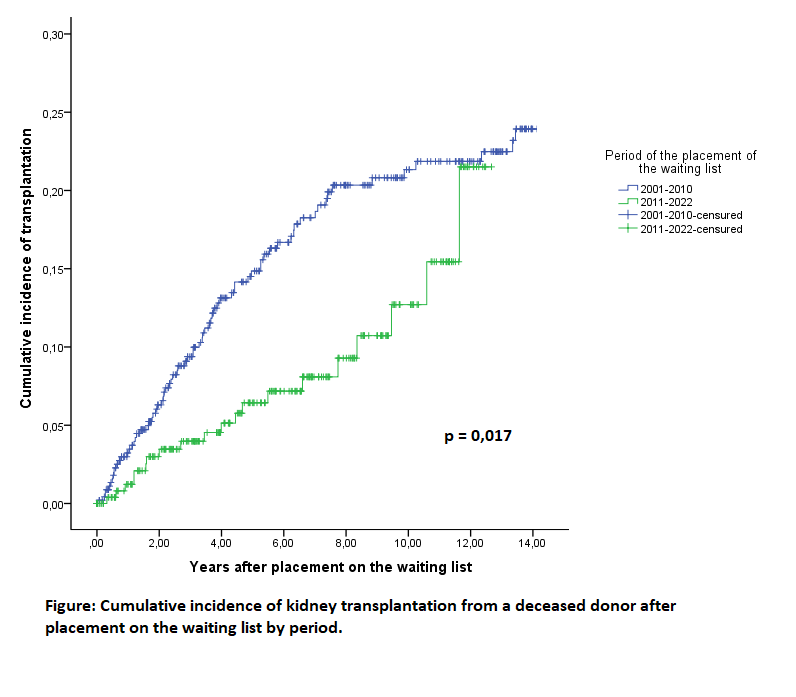Impact of the 2011 Tunisian revolution on kidney transplantation accessibility from waiting list: a single center study
Fadwa Helaoui1, Mohamed Mongi Bacha1, Imen Nafti1, Rawen Ben Mansour1, Chifaa Trigui1, Mondher Ounissi1, Hafedh Hedri1, Taieb Ben Abdallah1, Ezzedine Abderrahim1.
1Department of Internal Medicine A , Charles Nicolle Hospital, Tunis, Tunisia
Introduction: The Tunisian revolution on January 14, 2011, brought significant political changes that affected public health. This study aims to examine how these political transformations impacted kidney transplantation from deceased donors (KTDD). Specifically, it seeks to compare the characteristics and outcomes in terms of access to kidney transplantation (KT) of patients registered on the national kidney waiting list (WL) before and after the revolution at Tunisia's oldest transplant center.Haut du formulaire
Methods: We conducted a retrospective cohort study at the Department of Internal Medicine “A” at Charles Nicolle Hospital in Tunis, focusing on patients with end-stage renal disease who were listed on the national WL for a DD kidney. We compared epidemiological, clinical, and biological characteristics as well as the access to KTDD of patients placed on the WL before (2001-2010) and after (2012-2022) the Tunisian revolution. Differences in proportions and means were tested using the chi-square test and t-test, respectively. Access to KTDD was assessed using the Kaplan–Meier method.
Results: Among the 782 patients studied, 493 (63.1%) were placed on the WL during the first period. There were significantly fewer women listed in the second period (37.4 vs 45.4%, p=0.028). The mean age at registration increased from 37.9 ± 11.1 years during the first period to 40.6 ± 11.9 years during the second period (p=0.001). More patients with hepatitis C were listed between 2001 and 2010 (8.7 vs 2.1%, p=0.001). The transfusion rate at the time of registration was significantly higher during the first era (p=0.004). Patients registered in the second period had better albumin serum levels (43.5 ± 7.2 vs 41.1 ± 6 g/l, p<0.001).
Among the 98 KTDD performed in our center during the study period, 65 (66.3%) were carried out during the first period (p=0.017). There were no significant differences between the two periods in diabetes, hypertension and hepatitis B prevalences as well as type of dialysis, body mass index, mean hemoglobin level, and positive cytotoxic antibodies rate. Additionally, the time between the start of dialysis and registration was similar during the two study periods (4.4 ± 3.6 vs 4.1 ± 4 years).
Conclusion: Our study highlights significant shifts in the national WL pre- and post-Tunisian Revolution. Notably, there were changes in gender distribution, age at registration, hepatitis C prevalence, transfusion rate, and albumin serum levels between the two periods. Moreover, our study revealed less access to KTDD in the second era highlighting the need for further research and targeted interventions to enhance patient care and outcomes in KT post-revolution.
[1] Tunisian revolution
[2] kidney transplantation
[3] waiting list
[4] access to kidney transplantation
